Many associated Little India with Mustafa Centre, the huge 24-hour department store that sells almost anything. Yes, they practically sell everything including electronics, jewellery, shoes and fresh produce. And we all know of someone who would dash to Mustafa Centre to get that last-minute travel luggage. Other than Mustafa Centre, another well-known landmark in Little India is without doubt Tekka Centre or Market and the Arcade.
Although not part of the original Raffles Town or Jackson Plan, like the ethnic areas of
Kampong Glam and
Chinatown, the well-preserved Little India in Singapore evolved through trade-related activities and remain a magnet of all things that represent the Indian culture and heritage of Singapore. The area was developed around agriculture and cattle trading in the 19th century. Common traditional trades include garland-making, goldsmithing, and fortune-telling. Indian goldsmiths are prominent, as gold jewelry is culturally significant. Walk along Serangoon Road and you will see rows of bright and sparkling gold shops!
Think of spices, think of masala
thosai or dosai or the good old
roti prata. Think of curry. The aroma of piping buttery hot thosai, roti prata or chapati will make one dash to Little India. The spice trade was crucial for Singapore's establishment as a British trading post. Indian traders, especially Gujaratis, dominated the spice market in Little India. Valli Flour Mill, established in 1934, is a notable spice-grinding shop.
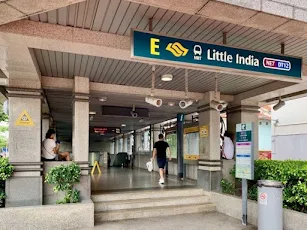 |
Little India MRT Station Exit E
|
The MRT station conveniently located at Little India makes Little India accessible. Little India is served by two MRT stations, one simply called Little India (blue and purple lines), which is closest to the heart of Little India near Tekka Centre or Market, and the other is Farrer Park Station (purple line), closer to Mustafa Centre. Which shows Little India is indeed quite big.
At Little India, you can get a tasty thosai or dosai (also spelled as dosa) for between $1.80 to $4, depending on if it's just good old plain thosai or a masala thosai stuffed with potatoes or one that include onion and egg. A delicious freshly baked chapati sells for only $1 a piece at some restaurants such as Azmi's along Norris Road. A bowl of plain curry sells for $1 too. You dip your chapati in curry. You can have
keema (minced mutton) for few dollars more. So, a set that contains two pieces of chapati and curry gravy or
keema sells for around $3 to $5. Azmi's has been around since 1944.
 |
| Chapati |
A piece of plain appam sells for $1.50 at Bala's, which is next to Azmi. And you can get two pieces of wadai or vadai at Bala's for $2. You also can get two pieces of
idli for $2. Idli is steamed fermented rice and lentils cake which is served with
sambar or vegetable curry and chutneys. Because most early Indian immigrants to Singapore were from Southern India, it is the cuisine of South that dominates. So thosai, chapati, prata, apam and idli are South Indian in origin.
Northern Indian dishes are less spicy, featuring wheat-based staples. North Indian food includes chicken tandoori and naan. And Indian meals are best eaten with hands. Fusion dishes like fish-head curry emerged from local influences. Just like food, you can find hindu temples in Little India, of both the north and south influences, with distinctive designs.
By the way, wadai or vadai is deep-fried dough with vegetables or shrimp commonly sold at
pasar malam or night markets here in Singapore. Best to eat while still hot and with fresh green chilli! If you want to make it even spicier get the little chilli padi.
 |
| Buffalo Road and Kerbau Road |
You can find tasty and affordable
roti-prata not only in Little India and but elsewhere across the island. Just like biryani. The crispier the
roti-prata, the better.
Roti-prata is commonly found in Malaysia too, our neighbouring country, but the dish is more commonly known as
roti canai.
Canai perhaps came from the word Chennai, a town in southern India, where the delicacy probably first originated.
Your roti-prata will not be complete without a cup of sweet
teh tarik (pulled tea), teh halia (with ginger added) or teh masala (masala spice tea) that sells for around $1.20 to $1.80. Little India is also a place where you can find many vegetarian food places, Indian style. Practically all-over Little India you will find street-side stores selling fresh vegetables and produce.
You can find the chain restaurants such as
Komala and
MTR in Little India. There is only one
MTR in Singapore. You can find
Komala, your vegetarian restaurant, in other parts of the island too. But for a more authentic experience, you cannot beat eating at non-airconditioned restaurants by the roadside.
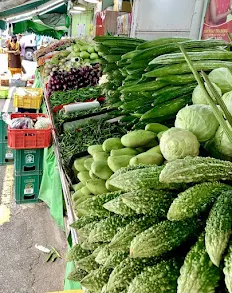 |
| Fresh produce at street stalls |
Little India will also remind one that it is the place to eat rice on banana leaf. Though many restaurants at Little India have gone upmarket and some common food like a plate of biryani will cost around $10 or slightly more. So, eating food served on banana leaves may no longer be a cheap experience. But fret not.
You can find the Bismillah restaurant that the late Anthony Bourdain went to at Little India in Dunlop Street. A plate is still less than $10 and it is a big plate of biryani good for two persons. It is non-greasy thus can be a bit dry too. And this restaurant is listed in Michelin Bib Gourmand Award. Certainly, worth a visit if you crave for biryani. You can get a slightly cheaper biryani at Tekka Market, but it is the typical dam biryani and there are at least five stalls there that sell biryani. Many people will enjoy eating the original greasy biryani.
For curry fish head, it will set you about $20 upwards in most restaurants though if there are few of you eating together then the cost will be more spread out. Curry fish head historically is a dish prepared by the earlier Indian migrants and labourers because the fish heads were all they could afford at the time, though it is now considered a delicacy. How times have changed.
 |
Biryani at Bismillah Restaurant
|
The streets names at Little India pretty much reflect the history. Race Course Road is named after the horse racing activities that were popular during the mid 1800 by the early colonial settlers in Singapore. Now you will find a number of upmarket Indian restaurants along Race Course Road like the famous Banana Leaf Restaurant and Sakunthala. And in an alleyway along Race Course Road in-between some Indian restaurants you will find some
street arts or wall murals by Jaxton Su, depicting horses and horse racing, to show the history of that particular street or area.
Buffalo Road and Kerbau Road (Kerbau is a Malay word for buffalo) shows that Little India was once thriving cattle rearing area. Around Kerbau Road is where Little India Arts Belt is located. And the nearby Belilios Lane is named after a cattle importer I.R. Belilios. And Dunlop Street is named after Colonel Samuel Dunlop, a member of Municipal Commission in 1887. You can see colourful and pretty wall murals and
street arts depicting Indian culture or trades all over Little India.
 |
| Indian Heritage Centre (R) and Little India Arcade (L) |
Other than Dunlop Street, there are many streets' names after bungalow owners such as Cuff Road, Desker Road, Norris Road, Rappa Terrace and Rowell Road. And streets named after British governors or officials include Birch Road, Clive Street, Dalhousie Lane, Dickson Road, Hastings Road, Owen Road, Weld Road and of course Campbell Lane, which during festivities like Deepavali has a bazaar like atmosphere with street markets selling varieties of costume, jewellery, handicrafts festive items, food and spices.
While at Kerbau Road check out the former House of Tan Teng Niah. You will not miss the colourful house, the last surviving Chinese villa in Little India which was built in 1900. Tan Teng Niah was the owner of a confectionery business and owned several sweet-making factories along Serangoon Road and a rubber smokehouse on Kerbau Road. Above the entrance of the villa hung a gilded engraved name plate with the calligraphic inscription Siew Song, meaning "elegant prince". This villa was built for his wife. However, the villa is now occupied by a commercial office.
 |
| Tan Teng Niah House |
The main street in Little India is a long stretch of Serangoon Road, one of the oldest roads in Singapore, dating back to 1822, during Sir Stamford Raffles time, who first arrived in Singapore in 1819. The first Indians to arrive in Singapore were
lascars or an army unit of Indian soldiers of the Bengal Infantry who accompanied Sir Stamford Raffles in 1819.
Serangoon Road probably takes its name from the Malay word saranggong,
ranggong being a marsh bird or 'Serangoon dengan gong', which means to beat a gong. On an 1828 map, Serangoon Road was labelled 'road leading across the island'. Serangoon Road proper was laid by convicts held at the 19th century prison on Bras Basah Road.
The large number of Indian convicts at the prison, those who settled outside its walls and those who provided supporting trades formed the genesis of this Indian district. During the early years, Indian convicts were sent to Singapore to build roads and government offices. Subsequently, Indian businessmen, civil servants and teachers flocked to Singapore as it developed into one of the busiest port-cities.
Today the most visible trade along Serangoon Road are the goldsmiths shops. In Indian culture and Hinduism, gold jewellery forms significant parts of family heirlooms and functions as a status symbol. It is showcased during important occasion including given as gifts or worn during festive occasions.
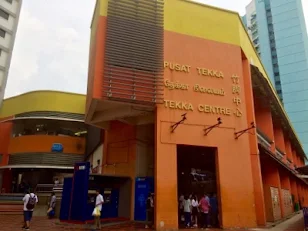 |
| Tekka Market (Tekka Centre) |
Tekka Market, established in 1915, was a key marketplace for fresh produce. A large potpourri or mixture of wet market at lower ground floor and a
hawker centre at upper ground floor that sells local fare such as Indian rojak, biryani and roti-prata and drinks such as lassi and coconut.
Stores selling traditional Indian clothing and textiles are located on the upper floor. Affordable fresh groceries and tasty wide range of local fare can certainly be enjoyed at Tekka Centre. If you are looking for an old style pay phone which is a rarity nowadays the likelihood, you can find one at Tekka Market.
Tekka in Hokkien, a Chinese dialect, means bamboo clumps. Bamboo once grew abundantly on the banks of Rochor Canal, near Little India. The nearest MRT station to Tekka Centre and Little India Arcade is Little India MRT station, exit E. In the early 1980s, the market was redeveloped and was renamed as Zhujiao Market, a Chinese transliteration of "Tekka". In 2000, the market was renamed Tekka Centre to reflect the history of the place after public feedback that Zhujiao bore little resemblance to its former name.
 |
| Wall murals/ arts at Bellilios Lane |
At Little India Arcade along Serangoon Road, you will find some sweet candy and Indian snack stores, and stores selling bangles, souvenirs and clothes. If you want to get your hand dyed with some nice temporary tattoos or designs, you will find some shops selling henna tubes and they do the pretty hand painting for between $5 to $20.
And for a few dollars you can have your future read out to you by a parrot astrologer. A parrot, the bird parrot, will pick out a card from a deck of cards. Other than that, you will also find mostly souvenirs stores selling Indian handicrafts and knick-knacks.
A little gem in Little India Arcade is a little museum which has some artefacts such equipment or moulds used for cooking muruku and various other displays. And the street art along Belilios Lane depicts typical Indian trades. You can see a dhoby woman (Dhoby Ghaut is named after dhobi industry along a previous Stamford canal), a milkman, garland makers and of course the parrot astrologer.
 |
| 24-hour Mustafa Centre along Syed Alwi Rd. |
What is Little India without Mustafa Centre? That is the magnet that attract tourists not only from the Indian subcontinent but tourists all over the world. Whatever you are looking for, Mustafa will have it. From clothes to groceries, electronics, jewelry and gold. If you are looking for some last-minute luggage bag, that's the place many visitors and locals will head to as they opened 24-hour.
But while many things are slightly cheaper at Mustafa, they are probably things that you can find elsewhere in Singapore too, Singapore being a shopping destination. What Mustafa provides is convenience, and just browsing and looking at the number of items on display at the super hypermart is an amazing experience by itself.
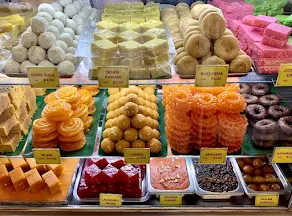 |
| Indian sweets and snacks |
Mustafa Centre is made up of two buildings connected to each other. There are six entrances. As Mustafa Centre opens 24-hr it is best that you go during off-peak days or hours. Sundays can very crowded at Mustafa Centre, and in Little India in general, as both locals and Indian migrants' residence congregate to shop, eat and to meet friends.
Syed Alwi Road was originally named Syed Allie Road after a well-known Arab merchant, Syed Allie bin Mahomed Aljuneid. After Syed Allie's death in 1858. his son Syed Alwi wound up his estate there and filled in a large swamp purchased by his father.
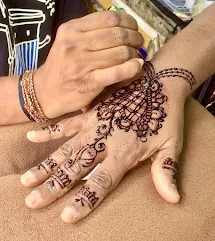 |
| Henna hand tattoo design |
Do walk around the preserved shophouses, smell and enjoy the spices, the curry, the stringed jasmine flowers, the colourful and bright sweet snacks of burfy, gulab jamun, kesari, ghee balls, halwa, badusha, coconut candy or ladoo (laddu), the saris and salwar kameez, the fresh vegetable stores, where you can get a big bag of potatoes for only $5. Where spices like dried chilli, fennel, coriander, cinnamon and cumin are still sold from old-school gunnysacks. Jasmine symbolizes purity and is used in Hindu rituals. The shophouses dated from the early shophouses style at Buffalo Street to the more modern style along Serangoon Road. The first transitional, late style and art deco style shophouses can be found in Little India.
Ladoo is a popular South Indian ball or sphere-shaped sweets or snacks made of flour, sugar and cooked in ghee and depending on the types of
ladoos the ingredients may include raisin, cashews and almonds. In India a bubbly boy is affectionately called Ladoo. Little India is where one can also get an ayurvedic hot oil head message. Or a henna tattoo. A simple henna tattoo will cost $5. A more elaborate ones will be $10 or more. Henna is a leaf that is dried and ground and used as natural dye and conditioner. Traditionally it is applied to the palms of a bride to create intricate designs called "Mehendhi".
 |
| Fluffy idli set with masala tea. |
And do not forget to visit the Indian Heritage Centre showcasing the history of Indians in Singapore. It is along Campbell Lane with its gleaming mirror facade. While the building design may look modern amongst traditional street markets and shophouses, the facade is actually inspired by 'baoli' or Indian step wells. It has five permanent galleries with over 400 interesting artefacts on display. Little India is indeed a colourful place steeped in history and charming old-school images like no other.
Or if you just looking for a good cuppa of tea, then you will not have problem finding a good cuppa of milk tea in Little India. A masala or ginger tea perhaps? Little India in Singapore is indeed as authentic as it can be, just like southern part of India, where the early Indian immigrants came from.
 |
| Deepavali light-up along Serangoon Road |
One of the best times to visit Little India is during festivities such as Ponggal, a harvest festival, or Deepavali, which is a festival of light and is celebrated with Rangoli art. The first day of Deepavali is a public holiday in Singapore. Hindus celebrate Deepavali to commemorate the triumph of good over evil and light over darkness.
You will see the whole length of Serangoon Road decorated with festive greetings from lamp post to lamp post and the lights will be lighted up in the evening. Great for photo taking. There are also street markets stalls along Campbell Lane opposite Tekka market. Looking and just browsing at the array of goods related to festivities is quite an experience. So, if you are looking for an authentic traditional experience head to Little India.














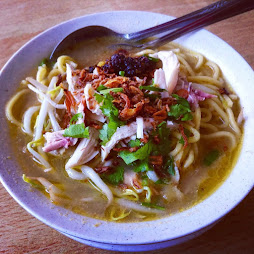


Comments
Post a Comment